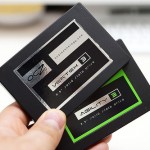Buy an SSD Using Data
05 June 2012
I decided to buy a solid state disk (SSD) for my home computer, and want the best deal possible. I require three things: low price, fast performance, and good reliability. Which drive has the best mix of the three? Let’s find out using my favorite tool: data!
Performance
Most of us do not have a collection of SSDs and a test rig. Luckily, there are great websites that do have these things and publish their results. I used two of the most popular: AnandTech.com and TomsHardware.com. A quick check shows that there are 12 SSDs that were recently reviewed by both sites.
Price
I chose a reputable website (Newegg.com) and looked up prices. I don’t use mail-in rebate prices because rebates are notoriously hard to redeem. This part was very, very easy.
Reliability
Reliability data is also available online, sort of. I like to crowd-source my reliability data from feedback consumers leave on large sites. We’ll use Amazon.com and Newegg.com ‘star’ ratings. Let’s consider both the scores and the number of reviews posted. The reason to look at counts is because a large enough number of reviews implies the wisdom of the crowds is accurate (statistically significant is the technical term).
Analysis
To start with, I put everything into an Excel file. Then I uploaded the data into a common visualization tool, Tableau. To start, let’s look at price versus performance.
The drives we are interested in are in the upper-left corner; they have the best performance and are also cheap. 6 SSDs qualify:
- Plextor M3
- Samsung SSD 830
- OCZ Vertex 3
- Corsair Performance Series Pro
- Intel SSD 520
- Kingston HyperX
The color represents the ratings given to each SSD by customers. One of them (in red) has bad ratings: the OCZ Vertex 3. We therefore eliminate it from our list. If we look a little closer at the data, 2 SSDs are pricier and slower than others: the Intel SSD 520 and Corsair Performance Series Pro. We therefore eliminate them as well, leaving us with 3 drives: the Kingston HyperX, Samsung SSD 830, and Plextor M3. They are all fast, and all under $280. Time to look at some different data.
Here we see performance scores vs. customer ratings for 3 different performance tests. The SSDs trend (roughly) from bottom-left to upper-right in each graph, indicating that review scores get better as the performance improves. That makes sense; we expect to see faster drives create happier customers. This time the interesting SSDs are in the upper-right corner; they have good customer reviews and good performance.
Three SSDs fit this criteria:
- Samsung SSD 830
- Kingston HyperX
- Intel SSD 520
We have already eliminated the Intel drive because it is pricey, which leaves us with 2 that pass our price filter and our ratings filter. I would be confident getting either drive. Success!
Conclusion: Samsung SSD 830 and Kingston HyperX
